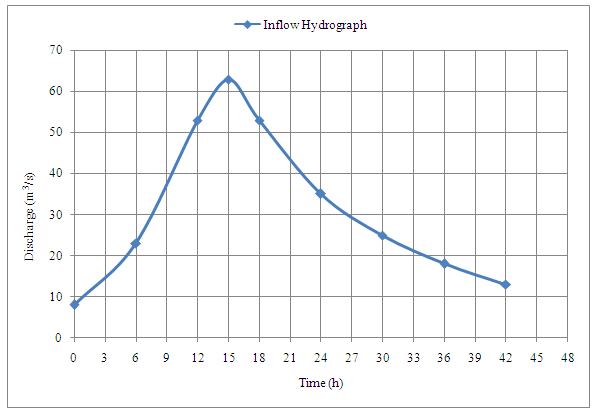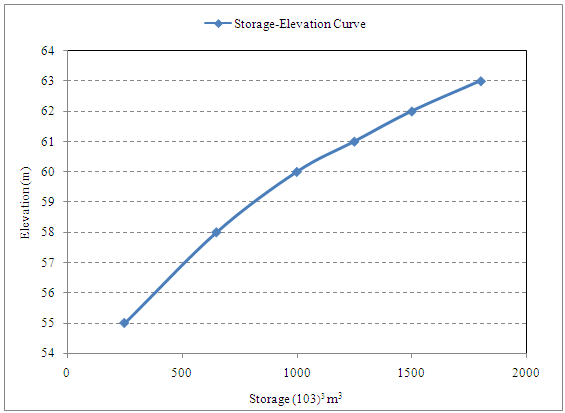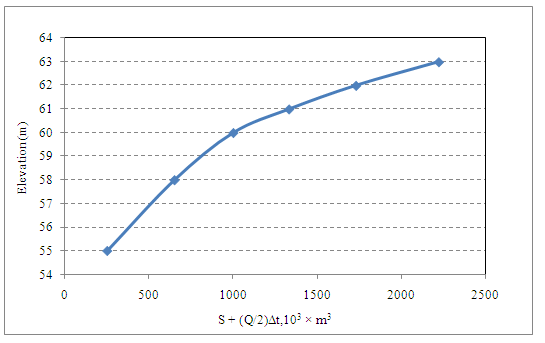Site pages
Current course
Participants
General
Module.1 Introduction of Water Resources and Hydro...
Module.2 Precipitation
Module.3 Hydrological Abstractions
Moule.4 Types and Geomorphology of Watersheds
Module 5. Runoff
Module 6. Hydrograph
Module 7. Flood Routing
Module 8. rought and Flood Management
19 April - 25 April
26 April - 2 May
Lesson 29 Hydrologic Reservoir Routing
29.1 Definition and Types of Flood Routing
Flood routing is the technique of determining the flood hydro graph at a section of a river by utilizing the data of flood flow at one or more upstream sections.In these applications two broad categories or routing can be recognized. These are:
29.1.1Reservoir Routing
In Reservoir routing the effect of a flood wave entering a reservoir is studied. Knowing the volume-elevation characteristic of the reservoir and the outflow-elevation relationship for the spillways and other outlet structures in the reservoir, the effect of a flood wave entering the reservoir is studied to predict the variations of reservoir elevation and outflow discharge with time. This form of reservoir routing is essential (i) in the design of the capacity of spillways and other reservoir outlet structures, and (ii) in the location and sizing of the capacity of reservoirs to meet specific requirements.
29.1.2Channel Routing
In Channel routing the change in the shape of a hydrograph as it travels down a channel is studied. By considering a channel reach and an input hydrograph at the upstream end, this form of routing aims to predict the flood hydrograph at various sections of the reach. Information on the flood-peak attenuation and the duration of high-water levels obtained by channel routing is of utmost importance in flood-forecasting operations and flood-protection works.
29.2 Uses of Flood Routing
The hydrologic analysis of problems such as flood forecasting, flood protection, reservoir design and spillway design invariably include flood routing.
29.3 Methods of Flood Routing
A variety of routing methods are available and they can be broadly classified into two categories as: (i) hydrologic routing, and (ii) hydraulic routing.
Hydrologic-routing methods employ essentially the equation of continuity.
Hydraulic methods, on the other hand, employ the continuity equation together with the equation of motion of unsteady flow. The basic differential equations used in the hydraulic routing, known as St. Venant equations afford a better description of unsteady flow than hydrologic methods.
29.4 Basic Equations
The passage of a flood hydrograph through a reservoir or a channel reach is an unsteady-flow phenomenon. It is classified in open-channel hydraulics as gradually varied unsteady flow. The equation of continuity used in all hydrologic routing as the primary equation states that the difference between the inflow and outflow rate is equal to the rate of change of storage, i.e.
 (29.1)
(29.1)
WhereI is inflow rate, Q is outflow rate and S= storage
Alternatively, in a small time interval Δt the difference between the total inflow volume and total outflow volume in a reach is equal to the change in storage in that reach
 (29.2)
(29.2)
Where is average inflow in time Δt, is average outflow in time Δt, and change in storage.
By taking ![]() , and ΔS = S2 - S1 with suffixes 1 and 2 to denote the beginning and end of time interval Δt, Eq. 29.2 is written as
, and ΔS = S2 - S1 with suffixes 1 and 2 to denote the beginning and end of time interval Δt, Eq. 29.2 is written as
 (29.3)
(29.3)
The time interval Δt should be sufficiently short so that the inflow and outflow hydrographs can be assumed to be straight lines in that time interval. Further Δt must be shorter than the time of transit of the flood wave through the reach.
In the differential form the equation or continuity for unsteady now in a reach with no lateral flow is given by
 (29.4)
(29.4)
Where T is top width of section, y isdepth of flow
The equation of motion for a flood wave is derived from the application of the momentum equation as
 (29.5)
(29.5)
WhereV is velocity of flow at any section, S0is channel bed slope;Sf is slope of the energy line.
Equation 29.4 and 29.5 are commonly known as St. Venant equations
 (29.3)
(29.3)
29.5 Hydrologic Reservoir Routing using Modified Pul’s Method
Equation 29.3 is rearranged as
At the starting of flood routing, the initial storage and outflow discharges are known.
This method requires construction of only two curves (i) S curve and (ii) ![]() curve.
curve.
Following steps are followed to compute reservoir hydrologic routing using Modified Pul’s method.
- From the inflow hydrograph, obtain the volume of water entering the reservoir in the short time interval, i.e., Compute average inflow
 .
. - For an initial outflow obtain from S curve and compute
 .
. - Add average inflow
 and
and  to obtain
to obtain  .
. - Using computed values
 , obtain Q2 from the
, obtain Q2 from the  curve.
curve. - Repeat the entire procedure to complete the routing.
Example 1
A small reservoir has the following storage elevation relationship
|
Elevation (m) |
55.00 |
58.00 |
60.00 |
61.00 |
62.00 |
63.00 |
|
Storage (103 m3) |
250 |
650 |
1000 |
1250 |
1500 |
1800 |
A spillway provided with its crest at elevation 60.00 m has the discharge relationship. Q = 15H3/2, where H = head of water over the spillway crest.When the reservoir elevation is at 58.00 m a flood as given below enters the reservoir.
Route the flood and determine the maximum reservoir elevation, peak outflow and attenuation of the flood peak using Modified Pul’s method.
|
Time (h) |
0 |
6 |
12 |
15 |
18 |
24 |
30 |
36 |
42 |
|
Inflow (m3/s) |
8 |
23 |
53 |
63 |
53 |
35 |
25 |
18 |
13 |
Answer




|
Routing period |
I1(m3/s) |
I2(m3/s) |
|
Q1(m3/s) |
|
|
Q2(m3/s) |
Elevation at beginning (m) |
Elevation at end (m) |
|
0-3 |
8 |
14.5 |
121.5 |
0 |
650 |
771.5 |
0 |
58 |
58.6 |
|
3-6 |
14.5 |
23 |
202.5 |
0 |
771.5 |
974 |
0 |
58.6 |
59.8 |
|
6-9 |
23 |
38.5 |
332.1 |
0 |
974 |
1306.1 |
13 |
59.8 |
60.8 |
|
9-12 |
38.5 |
53 |
494.1 |
13 |
1165.7 |
1659.8 |
39 |
60.8 |
61.9 |
|
12-15 |
53 |
63 |
626.4 |
39 |
1238.6 |
1865 |
52.5 |
61.9 |
62.4 |
|
15-18 |
63 |
53 |
626.4 |
52.5 |
1298 |
1924.4 |
57 |
62.4 |
62.5 |
|
18-21 |
53 |
43 |
518.4 |
57 |
1308.8 |
1827.2 |
50.5 |
62.5 |
62.3 |
|
21-24 |
43 |
35 |
421.2 |
50.5 |
1281.8 |
1703 |
42 |
62.3 |
62 |
|
24-27 |
35 |
29 |
345.6 |
42 |
1249.4 |
1595 |
35 |
62 |
61.8 |
|
27-30 |
29 |
25 |
291.6 |
35 |
1217 |
1508.6 |
29 |
61.8 |
61.6 |
|
30-33 |
25 |
22 |
253.8 |
29 |
1195.4 |
1449.2 |
24 |
61.6 |
61.4 |
|
33-36 |
22 |
18 |
216 |
24 |
1190 |
1406 |
20.5 |
61.4 |
61.2 |
|
36-39 |
18 |
15 |
178.2 |
20.5 |
1184.6 |
1362.8 |
17 |
61.2 |
61.05 |
|
39-42 |
15 |
13 |
151.2 |
17 |
1179.2 |
1330.4 |
14 |
61.05 |
60.9 |
References
Subramanya, K.(2008). Engineering Hydrology.Third edition, Tata McGraw Hill, 280-290.
Suggested Reading
Singh, V. P. (1994). Elementary Hydrology.Prentice Hall of India Private Limited, New Delhi.


